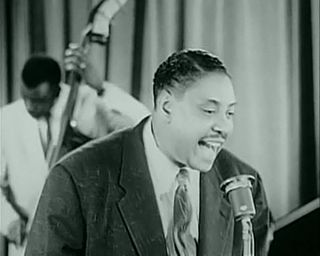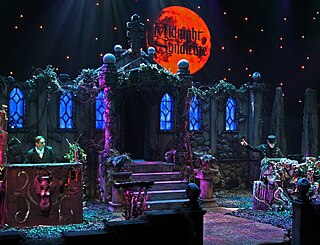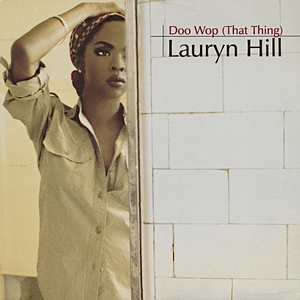| Halloween music | |
|---|---|
Toccata and Fugue in D minor, BWV 565 has been described as "the perfect piece of Halloween music" [1] | |
| Stylistic origins | Blues |
| Cultural origins | Halloween |
| Typical instruments | |
Halloween music is a music genre defined by themes of horror and popularity in association with the holiday of Halloween.
Halloween music is vaguely-defined and ambiguous, but is most commonly considered to include any song that increases in popularity seasonally around two weeks before Halloween. [2] These songs typically include themes of the supernatural, fright, and folklore, and may be intended to arouse fear in listeners. [3] Halloween music has also been associated with goth music. [4]
Halloween music's precursor is blues music, which was nicknamed "the devil's music" by detractors. The genre featured secular, and often sexual, lyrics, as well as themes relating to racial oppression. For these reasons, detractors associated it with unholiness. Blues music is defined in part by the blues scale, which can be used to create dissonant and "spooky" sounds. Blues music influenced Halloween songs such as "I Put a Spell on You". [3]
In the 1950s and 1960s, various doo-wop groups, groups influenced by blues music, began to release novelty Halloween-themed songs. "Monster Mash" is an example of such a novelty doo-wop Halloween song. Despite its Halloween themes, doo-wop Halloween music from this era is largely indistinguishable from non-Halloween themed doo-wop music in terms of musical characteristics. [3]
Following the 1960s, Halloween music began to split into various other genres aside from the blues and doo-wop. Classic and hard rock music also included sinister themes, and as such have been associated with Halloween. Songs such as "Highway to Hell" and "Sympathy for the Devil", which are both often considered to be Halloween music, feature blues notes and blues-inspired chord progressions. [3]
In the 1970s and 1980s, horror films grew in popularity, and horror film soundtracks also began to be associated with the holiday. The soundtracks of The Exorcist , The Shining , and Halloween are all considered Halloween music. [3]
Halloween music, while diverse, often features certain musical techniques used to unnerve listeners. Techniques used include dissonance between notes and the use of tritones, [3] as well as irregular time signatures. [5] Ostinato is used to create suspense in Halloween music, with a famous example being the repeated notes in the theme song of Jaws . [3] Halloween music often features certain instruments as well, such as the theremin and ondes Martenot, which were both in part popularized by horror film soundtracks. [3]
Halloween music in the United States increases in popularity around two weeks before October 31, at which point there is a spike in the amount of Halloween music listened to on services such as Spotify. [2] [6] Halloween music is most popular in the American state of Utah, and the largest demographic of people that listens to Halloween music is white women in their 30s and 40s. [2] [6] The most popular Halloween song in the United States is "Thriller" by Michael Jackson. [6]

Rhythm and blues, frequently abbreviated as R&B or R'n'B, is a genre of popular music that originated within African-American communities in the 1940s. The term was originally used by record companies to describe recordings marketed predominantly to African Americans, at a time when "rocking, jazz based music ... [with a] heavy, insistent beat" was becoming more popular. In the commercial rhythm and blues music typical of the 1950s through the 1970s, the bands usually consisted of a piano, one or two guitars, bass, drums, one or more saxophones, and sometimes background vocalists. R&B lyrical themes often encapsulate the African-American history and experience of pain and the quest for freedom and joy, as well as triumphs and failures in terms of societal racism, oppression, relationships, economics, and aspirations.

Ragtime, also spelled rag-time or rag time, is a musical style that had its peak from the 1890s to 1910s. Its cardinal trait is its syncopated or "ragged" rhythm. Ragtime was popularized during the early 20th century by composers such as Scott Joplin, James Scott and Joseph Lamb. Ragtime pieces are typically composed for and performed on piano, though the genre has been adapted for a variety of instruments and styles.

Doo-wop is a subgenre of rhythm and blues music that originated in African-American communities during the 1940s, mainly in the large cities of the United States, including New York, Philadelphia, Pittsburgh, Chicago, Baltimore, Newark, Detroit, Washington, D.C., and Los Angeles. It features vocal group harmony that carries an engaging melodic line to a simple beat with little or no instrumentation. Lyrics are simple, usually about love, sung by a lead vocal over background vocals, and often featuring, in the bridge, a melodramatically heartfelt recitative addressed to the beloved. Harmonic singing of nonsense syllables is a common characteristic of these songs. Gaining popularity in the 1950s, doo-wop was "artistically and commercially viable" until the early 1960s and continued to influence performers in other genres.

Horror punk is a music genre that mixes punk rock and 1950s-influenced doo-wop and rockabilly sounds with morbid and violent imagery and lyrics which are often influenced by horror films and science fiction B-movies. The genre was pioneered by the Misfits in the late 1970s and early 1980s. Subsequent bands formed in the Misfits' wake like Mourning Noise, the Undead and Samhain, solidifying horror punk's first wave. In the late 1990s and early 2000s the genre gained attention through the reunion of the Misfits and success of groups like AFI, Son of Sam and the Murderdolls. This popularity continued to the modern day with Blitzkid, Calabrese and Creeper.

Many musical styles flourished and combined in the 1940s and 1950s, most likely because of the influence the radio had in creating a mass market for music. World War II caused great social upheaval, and the music of this period shows the effects of that upheaval.

Andrew Maurice Gold was an American multi-instrumentalist, singer, songwriter, and record producer who influenced much of the Los Angeles-dominated pop/soft rock sound in the 1970s. Gold performed on scores of records by other artists, especially Linda Ronstadt, and had his own success with the U.S. top 40 hits "Lonely Boy" (1977) and "Thank You for Being a Friend" (1978), as well as the UK top five hit "Never Let Her Slip Away" (1978). In the 1980s, he had further international chart success as one half of Wax, a collaboration with 10cc's Graham Gouldman.
Boogaloo or bugalú is a genre of Latin music and dance which was popular in the United States in the 1960s. Boogaloo originated in New York City mainly by stateside Puerto Ricans with African American music influences. The style was a fusion of popular African American rhythm and blues (R&B) and soul music with mambo and son montuno, with songs in both English and Spanish. The American Bandstand television program introduced the dance and the music to the mainstream American audience. Pete Rodríguez's "I Like It like That" was a famous boogaloo song.
Horrorcore, also called horror hip hop, horror rap, death hip hop, death rap, or murder rap is a subgenre of hip hop music based on horror-themed and often darkly transgressive lyrical content and imagery. Its origins derived from certain hardcore hip hop and gangsta rap artists, such as the Geto Boys and Three 6 Mafia, which began to incorporate supernatural, occult, and psychological horror themes into their lyrics. Unlike most hardcore hip hop and gangsta rap artists, horrorcore artists often push the violent content and imagery in their lyrics beyond the realm of realistic urban violence, to the point where the violent lyrics become gruesome, ghoulish, unsettling, inspired by slasher films or splatter films. While exaggerated violence and the supernatural are common in horrorcore, the genre also frequently presents more realistic yet still disturbing portrayals of mental illness and drug abuse. Some horrorcore artists eschew supernatural themes or exaggerated violence in favor of more subtle and dark psychological horror imagery and lyrics.
A hook is a musical idea, often a short riff, passage, or phrase, that is used in popular music to make a song appealing and to "catch the ear of the listener". The term generally applies to popular music, especially rock, R&B, hip hop, dance, and pop. In these genres, the hook is often found in, or consists of, the chorus. A hook can be either melodic or rhythmic, and often incorporates the main motif for a piece of music.

Midnight Syndicate is an American musical duo that has been working primarily in the genre of neoclassical dark ambient music since 1997 and is based in Chardon, Ohio, a suburb of Cleveland.
Oldies is a term for musical genres such as pop music, rock and roll, doo-wop, surf music from the second half of the 20th century, specifically from around the mid-1950s to the 1980s, as well as for a radio format playing this music.
"The Purple People Eater" is a novelty song written and performed by Sheb Wooley, which reached No. 1 in the Billboard pop charts in 1958 from June 9 to July 14, No. 1 in Canada, reached No. 12 overall in the UK Singles Chart, and topped the Australian chart.

Music history of the United States includes many styles of folk, popular and classical music. Some of the best-known genres of American music are rhythm and blues, jazz, rock and roll, rock, soul, hip hop, pop, and country. The history began with the Native Americans, the first people to populate North America.

"Monster Mash" is a 1962 novelty song by Bobby "Boris" Pickett. The song was released as a single on Gary S. Paxton's Garpax Records label in August 1962 along with a full-length LP called The Original Monster Mash, which contained several other monster-themed tunes. The "Monster Mash" single was number one on the Billboard Hot 100 chart on October 20–27 of that year, just before Halloween. It has been a perennial Halloween favorite ever since. In 2021, nearly 60 years after its release, "Monster Mash" re-entered the Billboard Hot 100 chart at number 37.

American popular music is popular music produced in the United States and is a part of American pop culture. Distinctive styles of American popular music emerged early in the 19th century, and in the 20th century the American music industry developed a series of new forms of music, using elements of blues and other genres. These popular styles included country, R&B, jazz and rock. The 1960s and 1970s saw a number of important changes in American popular music, including the development of a number of new styles, such as heavy metal, punk, soul, and hip hop.

"Doo Wop (That Thing)" is a song by American recording artist Lauryn Hill for her debut solo studio album The Miseducation of Lauryn Hill (1998). It was written and produced by Hill. The song was released as her solo debut and lead single from The Miseducation of Lauryn Hill on August 10, 1998, by Ruffhouse Records and Columbia Records. No commercial release was originally intended for the single in the US, but limited-quantity physical formats were issued two months later, on October 27.
A revivalist artist or revivalist band is a musical group, singer, or musician dedicated to reviving interest in a musical genre from an earlier era.
Non-lexical vocables, which may be mixed with meaningful text, are a form of nonsense syllable used in a wide variety of music. Common English examples are "la la la", "na na na" and "da da da".

Vocal harmony is a style of vocal music in which a consonant note or notes are simultaneously sung as a main melody in a predominantly homophonic texture. Vocal harmonies are used in many subgenres of European art music, including Classical choral music and opera and in the popular styles from many Western cultures ranging from folk songs and musical theater pieces to rock ballads. In the simplest style of vocal harmony, the main vocal melody is supported by a single backup vocal line, either at a pitch which is above or below the main vocal line, often in thirds or sixths which fit in with the chord progression used in the song. In more complex vocal harmony arrangements, different backup singers may sing two or even three other notes at the same time as each of the main melody notes, mostly with a consonant, pleasing-sounding thirds, sixths, and fifths.
This article includes an overview of the major events and trends in popular music in the 1950s.